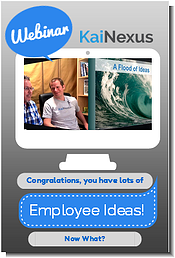 You may or may not know that we host a regular webinar series, with topics ranging from employee engagement and the ROI of continuous improvement to A3 Thinking and improvement software demos.
You may or may not know that we host a regular webinar series, with topics ranging from employee engagement and the ROI of continuous improvement to A3 Thinking and improvement software demos.
You can see what's coming up next here.
My favorite part of the webinars is that they give us a chance to listen to the audience; to see what questions people are asking, what topics resonate with them, and what their struggles are.
For example, one of the attendees in our webinar produced in partnership with Gemba Academy called "Congratulations, You Have Lots of Employee Ideas. Now What?" asked this question:
“We have successfully implemented a Quick and Easy Kaizen program where all our staff identify a problem, improve the problem, and submit the improvement for tracking. The problem I run into is in the submitting the problem and tracking the savings. Is it common for employees to say how much time they save for each of their ideas? And do organization often tie a dollar amount to the time savings? Are there pitfalls I should be aware of? (Example: Sally makes $12.00 an hour. She improved her process by one hour a day, so the total time savings is $12.00 an hour with an annual savings of $12.00 x number of work days left in the year.) Are there different ways to calculate the savings?”
Time savings IS commonly tracked.
So, let's address the first part of that question.
Yes, it’s common for people to track time savings as the result of Kaizen improvements both large and small. That makes sense, right? A LOT of the improvements your staff notice and implement will relate to making their work more productive and their customers happier, which often comes in the form of saving time.
It’s often easier to estimate and measure time savings than it is to come up with direct cost savings. Allowing people to complete improvements having "just" noted their time savings removes a barrier to engagement; they surely know how much time an improvement has saved them, even if they can't tie that directly back to a financial number. Let them share that data with their leaders!
Savings can be "hard" or "soft"
In the example posed by this webinar attendee, let’s say Sally saved thirty minutes a day. Some organizations look at that thirty minutes and feel content that improvement was made, time was saved, and perhaps employee or customer satisfaction has improved. If that's your organization, that's great!
Other organizations want to tie that time to a financial impact, which is equally great.
So for example, perhaps based on Sally's salary, that thirty minutes saves the organization $6 per day. Say that Sally uses her improvement platform to share that idea with nine of her counterparts - so she's now created a savings of $60 per day. Assuming the team is working 250 days per year, that's a total savings of $15,000 per year.
Not too shabby for a 30-minute improvement, eh?
Some people love that calculation, and others might be feeling squirmy about it.
Let's look at the two ways organizations can consider that savings.
Soft Savings
Many organizations will call Sally's annual impact of $15,000 “soft savings” because it’s not as direct as other “hard savings” categories (such a generating revenue or reducing costs). For example, if you have a Kaizen that reduces material waste and spending goes down by $50,000, that has a direct and measurable impact on the bottom line. You can reduce the budget by $50,000 and maybe spend that money in a more productive way.
The daily five staff hours that Sally's idea freed up, though, isn't likely to have a direct impact on the bottom line. You're still paying out those salaries, so you're not actually saving money. On the other hand, she's freed up five daily staff hours that can now be spent doing more value-added activities - perhaps allowing them to increase their volume, or take more time making customers happy. That's where we start to get into hard savings...
Hard Savings
Sally’s idea that saved time could also be considered "hard savings." For example, if it helped reduce overtime or the use of contract labor, it might then be considered a “hard savings.” If her idea allowed the organization to produce 20% more product (or see 20% more patients) with the same staff, we might count that extra revenue as a “hard benefit,” since that flows through to the bottom line.
So, as you can see, the way you interpret that time savings impact financially can depend on the nature of your business and your finance team. There's no one answer that fits everyone.
By impacting savings, you're likely also impacting other areas of the organization.
In many cases where an employee, like Sally, saved time, we are still paying her for a normal eight hours a day. Now, though, her time is probably being used in a better and more productive way. She might be producing more product or she might be spending more time at the bedside with patients. The non-financial impact of improvement ideas should never be discounted; it may have important indirect effects on the organization.
Examples of areas of the business that may be impacted by time-saving ideas, even those without a direct financial impact, may include
- Quality Improvements
- Staff Safety
- Customer / Patient / Vendor Safety
- Greater Staff Satisfaction
- Greater Customer / Patient Satisfaction
Any business worth its salt cares about these qualitative measures as well as the financial quantitative ones. Isn't it cool that time-saving improvements can impact so many areas of your organization at once?
The key takeaway here is that there are several different areas of savings that should be tracked when measuring the impact of your improvement efforts. Whether the impact is a "soft savings," a "hard savings," or an improvement to quality, safety, or satisfaction, reporting on the impact and recognizing the employees who contributed is an important aspect of continuous improvement.
Watch the free webinar that inspired this question here:
Congratulations, You Have Lots of Employee Ideas! Now What?

 Watch this free webinar to learn:
Watch this free webinar to learn:
- How to discuss ideas constructively with employees
- How to prioritize ideas (and if that's even necessary)
- How to assign responsibility for improvement work
- How to create time for improvement
- How to track improvements


Add a Comment